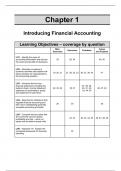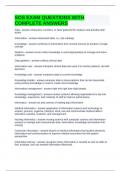Chapter 1
Introducing Financial Accounting
Learning Objectives – coverage by question
Mini- Cases
Exercises Problems
Exercises and Projects
LO1 – Identify the users of
accounting information and discuss 25 28, 34 49, 50
the costs and benefits of disclosure.
LO2 – Describe a company’s
business activities and explain how
19, 20, 21 27, 29, 32, 33 36, 37, 38, 43 47
these activities are represented by
the accounting equation.
LO3 – Introduce the four key
financial statements including the 37, 38, 39,
balance sheet, income statement, 22, 23, 24 30, 31 40, 41, 42, 46, 47, 49
statement of stockholders’ equity 43, 44, 45
and statement of cash flows.
LO4 – Describe the institutions that
regulate financial accounting and
26 34 50
their role in establishing generally
accepted accounting principles.
LO5 – Compute two key ratios that
are commonly used to assess
32, 33 36, 43, 44, 45 46, 47, 48, 49
profitability and risk – return on
equity and the debt-to-equity ratio.
LO6 – Appendix 1A: Explain the
conceptual framework for financial 35
reporting.
, QUESTIONS
Q1-1. Organizations undertake planning activities that subsequently shape three
major activities: financing, investing, and operating. Financing is the means
used to pay for resources. Investing refers to the buying and selling of
resources necessary to carry out the organization’s plans. Operating activities
are the actual carrying out of these plans. (Planning is the glue that connects
these activities, including the organization’s ideas, goals and strategies.)
Q1-2. An organization’s financing activities (liabilities and equity = sources of funds)
pay for investing activities (assets = uses of funds). An organization cannot
have more or less assets than its liabilities and equity combined and, similarly,
it cannot have more or less liabilities and equity than its total assets. This
means: assets = liabilities + equity. This relation is called the accounting
equation (sometimes called the balance sheet equation, or BSE), and it applies
to all organizations at all times.
Q1-3. The four main financial statements are: income statement, balance sheet,
statement of stockholders’ equity, and statement of cash flows. The income
statement provides information relating to the company’s revenues, expenses
and profitability over a period of time. The balance sheet lists the company’s
assets (what it owns), liabilities (what it owes), and stockholders’ equity (the
residual claims of its owners) as of a point in time. The statement of
stockholders’ equity reports on the changes to each stockholders’ equity
account during the year. Some changes to stockholders’ equity, such as those
resulting from the payment of dividends and unrealized gains (losses) on
marketable securities, can only be found in this statement as they are not
included in the computation of net income. The statement of cash flows
identifies the sources (inflows) and uses (outflows) of cash, that is, from what
sources the company has derived its cash and how that cash has been used.
All four statements are necessary in order to provide a complete picture of the
financial condition of the company.
Q1-4. The balance sheet provides information that helps users understand a
company’s resources (assets) and claims to those resources (liabilities and
stockholders’ equity) as of a given point in time.
An income statement reports whether the business has earned a net income
(also called profit or earnings) or a net loss. Importantly, the income statement
lists the types and amounts of revenues and expenses making up net income
or net loss. The income statement covers a period of time.
Q1-5. Your authors would agree with Mr. Buffett. A recent study of top financial
officers suggests they find earnings and the year-to-year changes in earnings
as the most important items to report. We would add cash flows particularly
from operations, and the year-to-year changes.
,Q1-6. The statement of cash flows reports on the cash inflows and outflows relating to
a company’s operating, investing, and financing activities over a period of time.
The sum of these three activities yields the net change in cash for the period.
This statement is a useful complement to the income statement which reports
on revenues and expenses, but conveys relatively little information about cash
flows.
Q1-7. Articulation refers to the updating of the balance sheet by information contained
in the income statement or the statement of cash flows. For example, retained
earnings is increased each period by any profit earned during the period (as
reported in the income statement) and decreased each period by the payment
of dividends (as reported in the statement of cash flows and the statement of
stockholders’ equity). It is by the process of articulation that the financial
statements are linked.
Q1-8. Return refers to income, and risk is the uncertainty about the return we expect
to earn. The lower the risk, the lower the expected return. For example, savings
accounts pay a low return because of the low risk of a bank not returning the
principal with interest. Higher returns are to be expected for common stocks as
there is a greater uncertainty about the realized return compared with the
expected return. Higher expected return offsets this higher risk.
Q1-9. Companies often report more information than is required by GAAP because
the benefits of doing so outweigh the costs. These benefits often include lower
interest rates and better terms from lenders, higher stock prices and greater
access to equity investors, improved relationships with suppliers and
customers, and increased ability to attract the best employees. All of these
benefits arise because the increased disclosure reduces uncertainty about the
company’s future prospects.
Q1-10. External users and their uses of accounting information include: (a) lenders for
measuring the risk and return of loans; (b) shareholders for assessing the
return and risk in acquiring shares; and (c) analysts for assessing investment
potential. Other users are auditors, consultants, officers, directors for
overseeing management, employees for judging employment opportunities,
regulators, unions, suppliers, and appraisers.
Q1-11. Managers deal with a variety of information about their employers and
customers that is not generally available to the public. Ethical issues arise
concerning the possibility that managers might personally benefit by using
confidential information. There is also the possibility that their employers and/or
customers might be harmed if certain information is not kept confidential.
, Q1-12. Return on equity (ROE) is computed as net income divided by average
stockholders’ equity (an average of stockholders’ equity for the current and
previous year is commonly used, but the ratio is sometimes computed only with
beginning or ending stockholders’ equity). The return on equity is a popular
measure for analysis because it compares the level of return earned with the
amount of equity invested to generate the return. Furthermore, it combines both
the income statement and the balance sheet and, thereby, highlights the fact
that companies must manage both well to achieve high performance.
Q1-13. While businesses acknowledge the increasing need for more complete
disclosure of financial and nonfinancial information, they have resisted these
demands to protect their competitive position. These companies must weigh
the benefits they receive from the market as a result of more transparent and
revealing financial reporting against the costs of divulging proprietary
information.
Q1-14. Generally Accepted Accounting Principles (GAAP) are the various methods,
rules, practices, and other procedures that have evolved over time in response
to the need to regulate the preparation of financial statements. They are
primarily set by the Financial Accounting Standards Board (FASB), an entity of
the private sector with representatives from companies that issue financial
statements, accounting firms that audit those statements, and users of financial
information.
Q1-15. International Financial Reporting Standards (IFRS) are the accounting
methods, rules and principles established by the International Accounting
Standards Board (IASB). The need for IFRS stems from the wide variety of
accounting principles adopted in various countries and the lack of comparability
that this variety creates. IFRS are intended to create a common set of
accounting guidelines that will make the financial statements of companies from
different countries more comparable.
The IASB has no enforcement authority. As a consequence, the strict
enforcement of IFRS is left to the accounting profession and/or securities
market regulators in each country. Many countries have reserved the right to
make exceptions to IFRS by applying their own (local) accounting rules in
selected areas. Some accountants and investors argue that a little diversity is
a good thing – variations in accounting practice reflect differences in cultures
and business practices of various countries. However, one concern is that
IFRS may create the false impression that everyone is following the same
rules, even though some variation will continue to permeate international
financial reporting.





